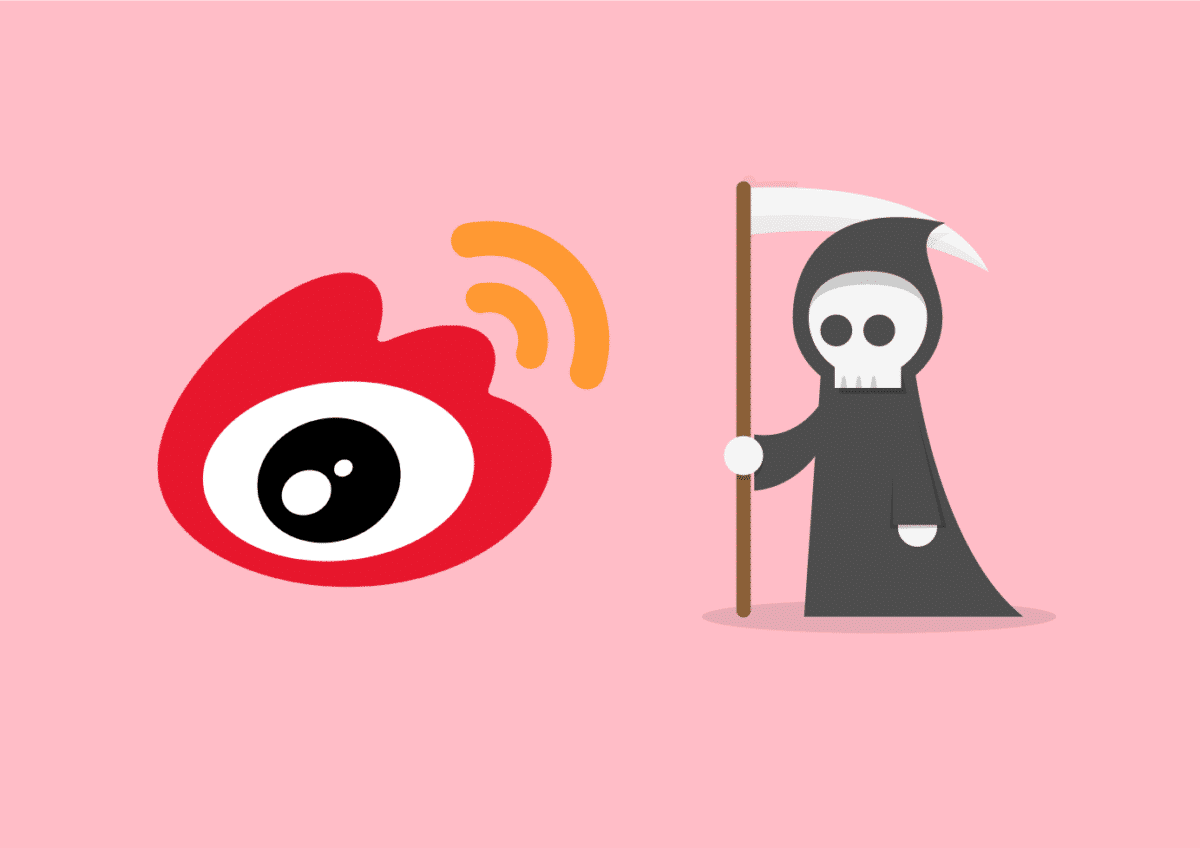Weibo used to be the one-and-only social platform in China – it has since been overshadowed by WeChat and newer entrants such as Toutiao or Douyin. Is Weibo dead, dying, or is it actually secretly striving?
A brief history of Sina Weibo
Weibo is usually known as the Chinese version of Twitter. In Chinese 微博(Weibo) means microblogging.
After Evan Williams created Twitter in 2006, a few Chinese companies saw the opportunity to create a similar platform for the local market:
- In August 2009, Sina launched Sina Weibo (Sina Weibo, being the largest micro-blogging platform in China, is usually simply referred as “Weibo”)
- Wangyi Weibo went online in 2010, in 2012 it claimed 260 million registered users; however, Wangyi Weibo disappeared in late 2014.
- Tencent launched Tencent Weibo in 2010, but the service didn’t gain significant traction. In 2014 Tencent announced it would stop investing into the development of Tencent Weibo.
- Sohu launched Sohu Weibo which never achieved significant market share
Of all of the “Twitter lookalikes” companies that launched in the early 2010′, only Sina Weibo survived to tell the tale.
However, its supremacy is now being challenged by new competitors acting as substitutes and competing for users time: WeChat, Toutiao, Zhihu, Douyin and more.
Weibo has performed outstandingly in the past, can it overcome this crisis?
Weibo marketing: how to promote your brand on Weibo?
Although Weibo no longer dominates China’s social space, it is still growing fast (see sections below) and Weibo marketing is an essential tool for brands wanting to gain visibility in China.
There are 5 main ways for brands to gain visibility on Weibo:
- Weibo Influencer campaigns
- Weibo advertising
- Weibo lottery
- Cross-promotion
- Organic growth
Weibo influencer campaigns
Weibo influencers are the most straightforward and efficient way to carry promotions on Weibo. The mechanism is a simple KOL promotion: pay or gift influencers in exchange for exposure.
There are however special features of Weibo which make the platform especially efficient for KOL marketing: its integration with Taobao and Tmall.
Users can click a product link or coupon displayed in a Weibo influencer post and be directly redirected to the relevant page on Taobao or Tmall.
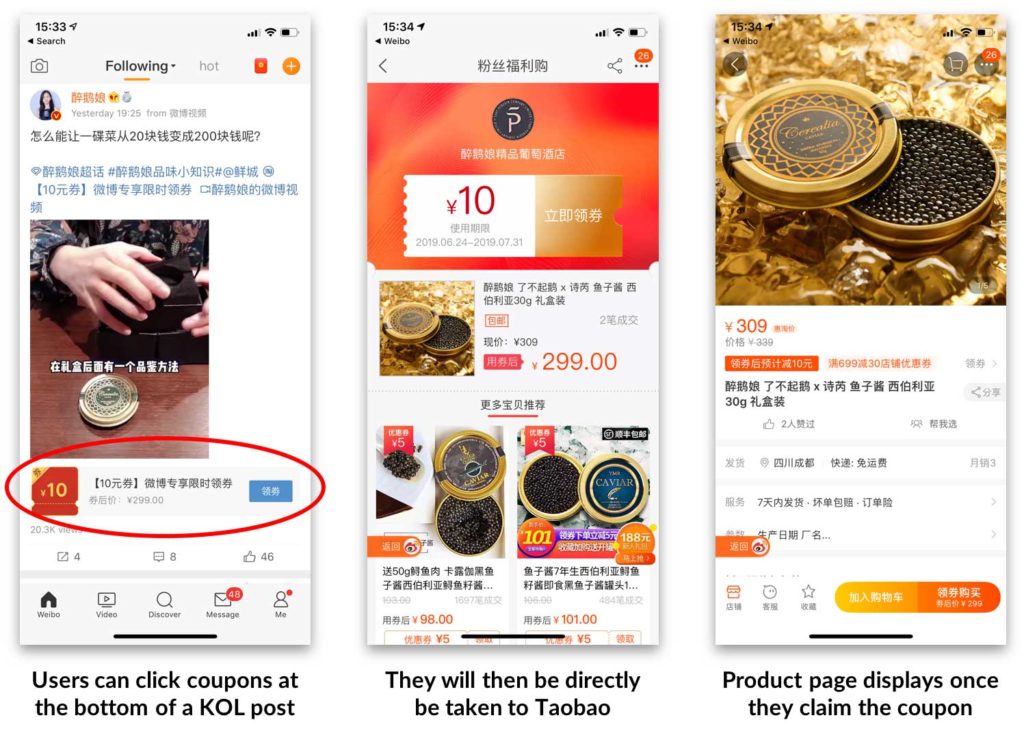
On top of these integrations, Weibo influencer campaigns are also extremely cheap. The CPM compared to WeChat is about 55 times cheaper!
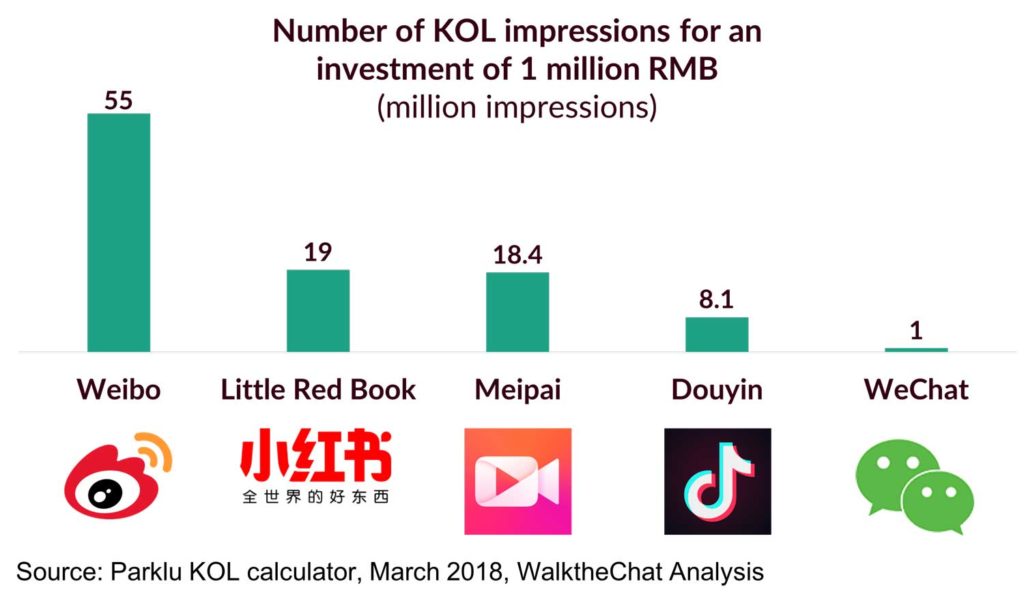
Weibo advertising
Weibo also has a powerful advertising back-end enabling to display advertising in users news feed.
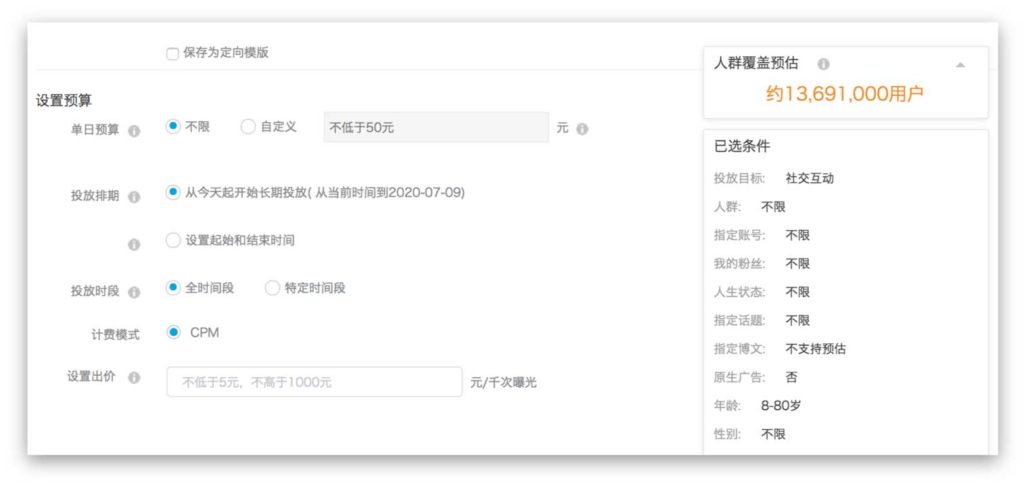
Compared to WeChat, Weibo ads have several advantages which make them stand out:
- Cheaper CPM
- Ability to target users following other accounts (including competitors)
- Retargeting users who participated in past campaigns
- Retargeting Tmall customers
- As for KOL, direct links to Taobao or Tmall
Weibo lottery
Weibo includes a native system enabling to design transparent lotteries for users to win prizes.
Although a lot of Chinese users might not trust the fairness of a lottery when it is completely organized by the brand, Weibo enables to design contests where users can take actions (like, share, etc.) and be rewarded in a transparent way with a prize (the winner is determined by the Weibo marketing system)
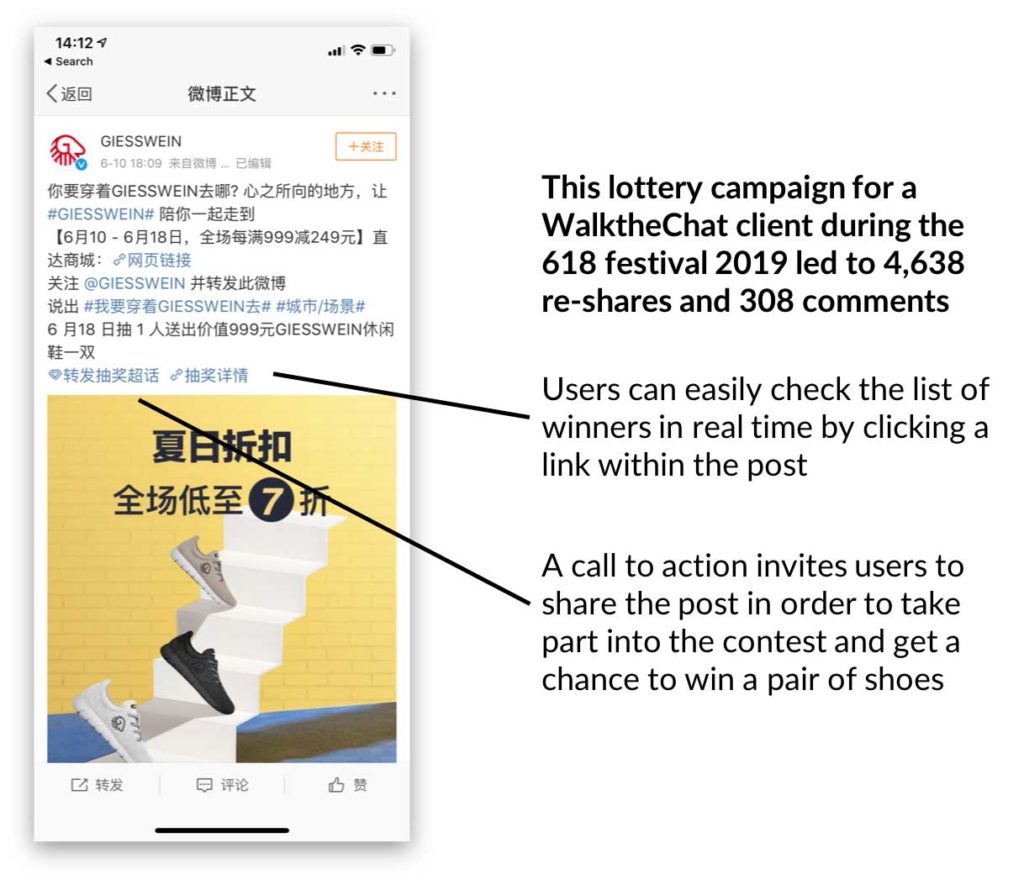
Cross-promotion on Weibo
Weibo is a powerful channel for B2C promotion, but it also works in another context: B2B promotion.
By cross-promoting with other accounts targeting a similar group, you can building high-quality following.
This also works in B2C space for brands sharing a similar positioning and aesthetics.
Organic growth
Finally the last medium of growth on Weibo is organic growth. By definition, it can’t easily be controlled or managed. Careful A-B testing of posts content (in order to increase engagement and re-shares) is however essential in order to generate significant organic growth.
Unlike WeChat, Weibo doesn’t display all content chronologically to users. Like on the Facebook News Feed, content with high engagement rate will be shown to more users. It is therefore essential to continually refine content quality (even if this means posting at a lower frequency)
Weibo is actually growing… fast
Weibo’s financial growth
Although it is true that we barely hear about Weibo anymore in the news, the company is nonetheless experiencing a significant financial growth.
Since 2014 Weibo has been experiencing steady growth of its revenue, with an increase of 76% in 2017.
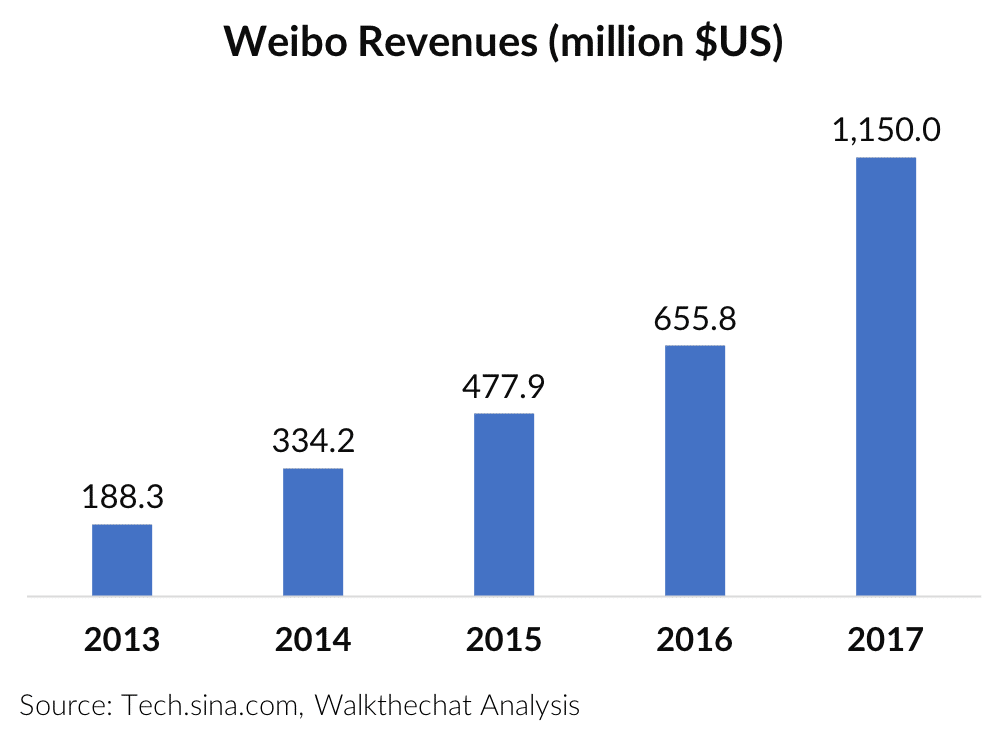
Most importantly, Weibo was able to increase its revenues from advertisement and marketing which had been a challenge for the company in the past.
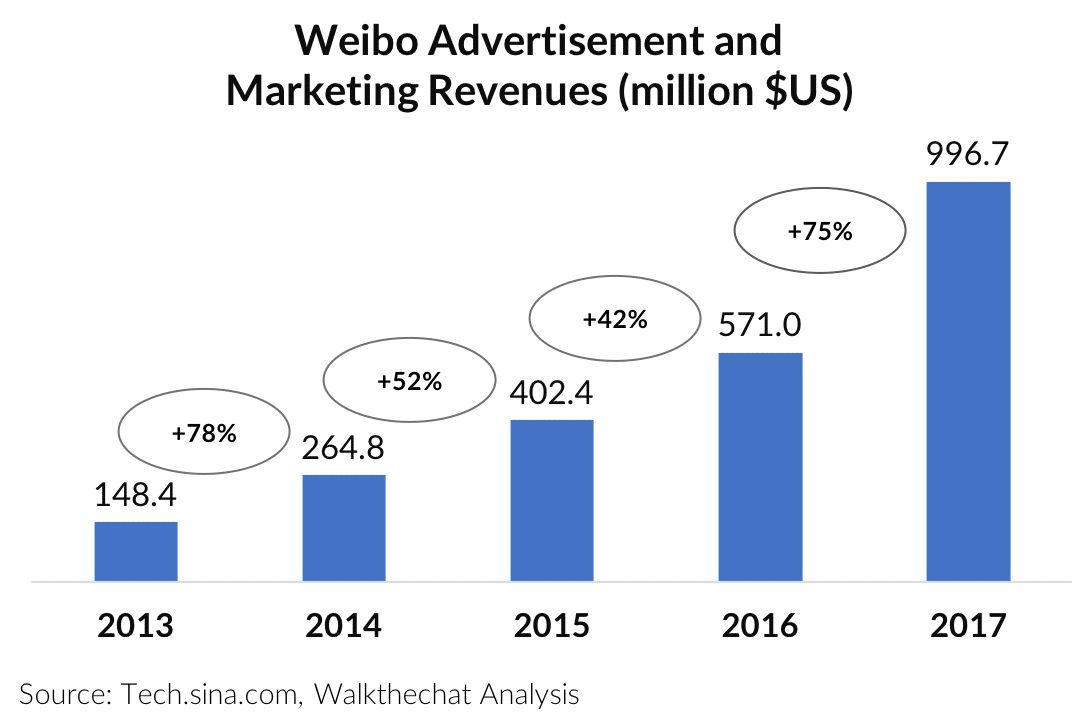
The growing advertising revenues from Weibo make sense even given the intense competition from WeChat: WeChat has notoriously not been promoting itself as an advertising network. Weibo offers CPM (cost for 1,000 advertising impressions) often 10 times cheaper than WeChat, with a high level of engagement and a smooth integration with Taobao/Tmall.
Who are Weibo users?
As of Q3 2017, 43.7% of Weibo’s users were women and 56.3% were men;
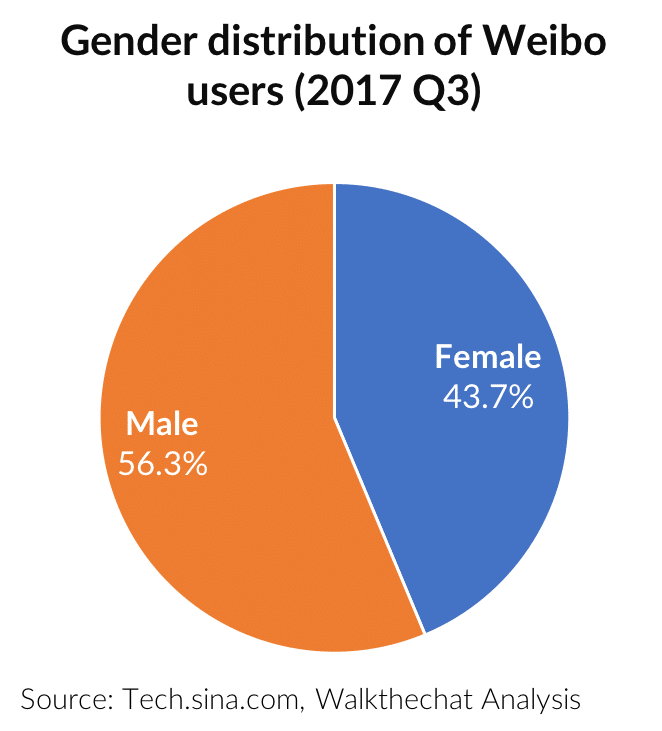
Besides, Weibo’s audience is mainly composed of young users, as of 2017 Q3, more than 80% of its users were less than 30 years old:
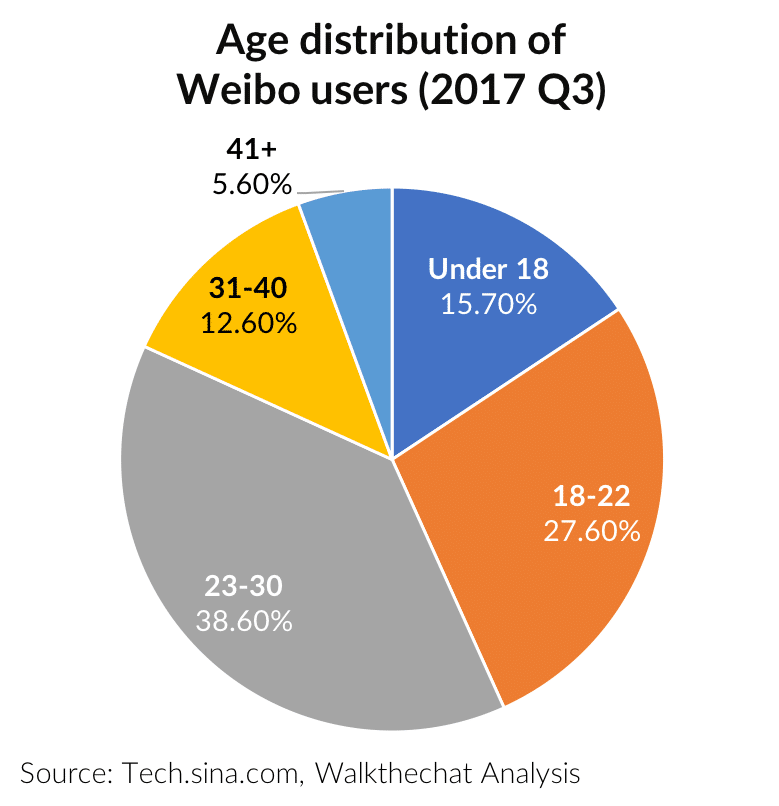
Slowing growth of Monthly Active Users
Weibo has been seeing a significant increase of MAU’s over the last few years. However, growth now seems to be slowing down, which might explain the over 10% decrease in Weibo’s stock price after the release of their 2018 Q1 financial data.

WEIBO AND ITS MAIN COMPETITORS
Weibo, as a pioneer in the micro-blogging market, will inevitably face imitation and competitors. Its main competitors are Toutiao and Zhihu. All of these products are becoming increasingly similar to Weibo.
All three products follow the model: ‘Content + Social’ and their strategy evolve around improving platform content’s quality (mostly by more relevant recommendations driven by artificial intelligence) or diversity and enhancing the social aspect of their product.
Toutiao and Zhihu have both integrated Weibo’s main design: news feed, share + comment + like and hot news. Toutiao in particular is becoming extremely similar to Weibo.
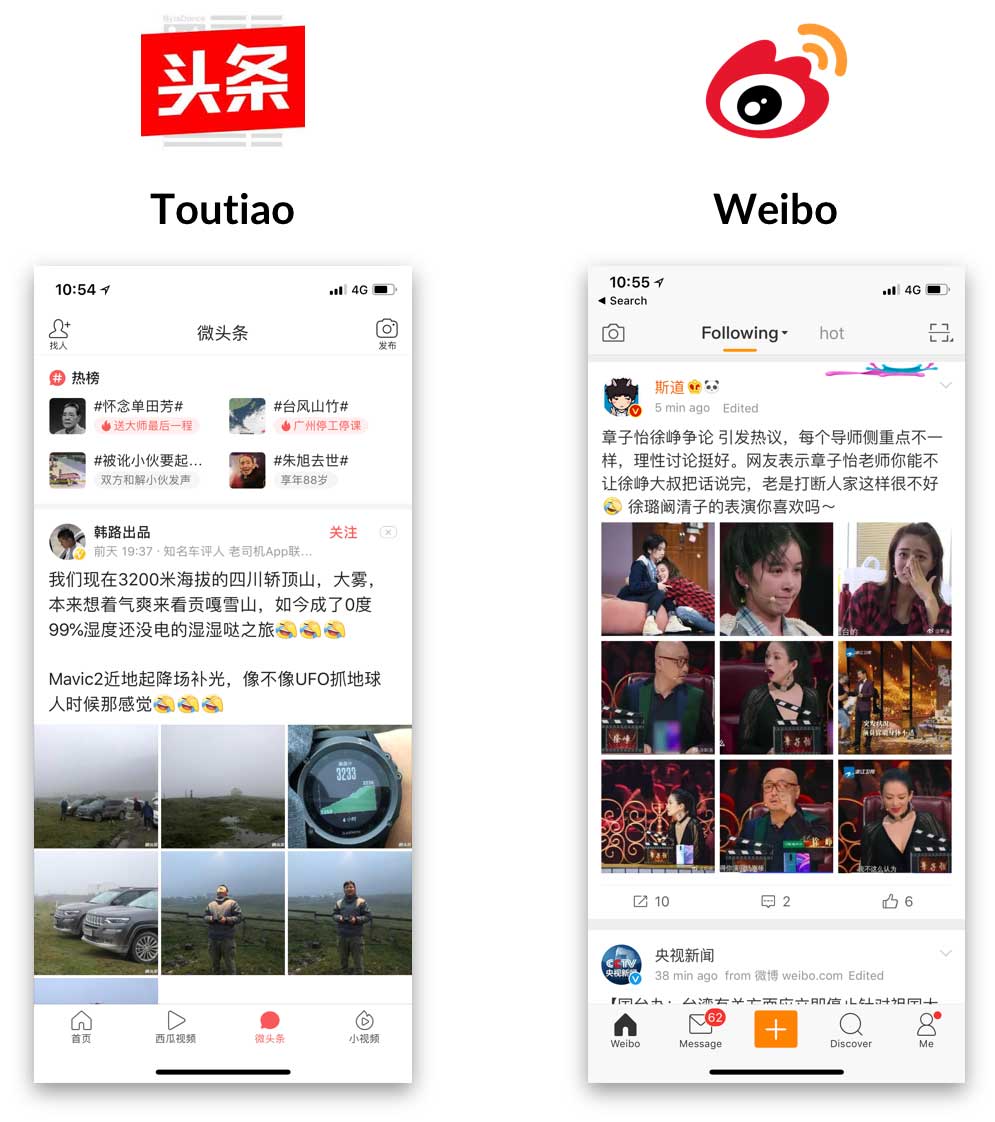
Toutiao was created in 2012 and is a content recommendation engine based on data mining. Its subsidiary products include the popular video platforms Douyin Short, Kuaipai and Xigua.
In 2014, Weibo invested in Toutiao and gained more than 20 times its investment; however, this investment turned out to be a double-edged word for Weibo. Why? Because Weibo fostered the growth of its biggest competitor: Toutiao has made itself into a second Weibo using Weibo’s data and money.
In fact, Toutiao was eager to make itself more than just a media platform, it aims to become a social media platform through short videos, live videos, contents, news and other forms of services; Weibo, unaware of their ambition, allowed Toutiao to use its resources to grow and expand.
Toutiao made several moves to take market share from Weibo:
- Recommended “Official Accounts” and hot topics: Toutiao started to recommend accounts for its users to follow, a typical Weibo function; as well as hot topics that are constantly being actualized, which is equivalent to Weibo’s daily trending topic ranking.
- Follow your friends: Toutiao has even allowed users to connect their account with their contact list, recommending users to follow their friends, which is showing a clear shift from a content platform to a social media platform.
- Short videos: to keep up with the market trend and internet users’ taste in short videos, Toutiao introduced Xigua, Douyin and other short video platforms onto its platform.
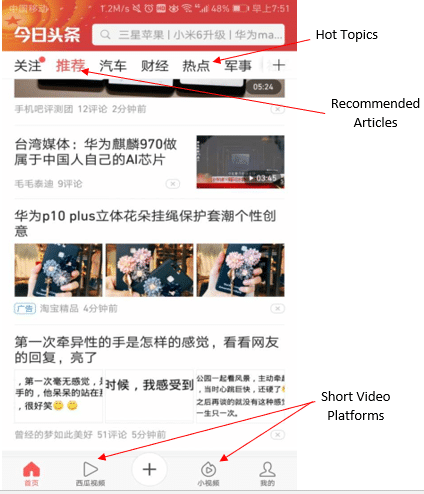
On the other hand, Weibo is not sitting still. Inspired by Toutiao’s core competitive advantage, Weibo also started to pro-actively recommend content to its users based on their interest.
The conflict between Toutiao and Weibo continues to intensify:
- In August 2017, Weibo accused Weitoutiao of illegally using Weibo’s content and ended its cooperation with Toutiao.
- A month later, Toutiao also deleted the URLs connecting with Weibo accounts.
- In 2018, Weibo blocked all links to Douyin, Toutiao’s booming short-videos platform
The three platforms, despite increasing similarities, also maintain some core differences:
- Toutiao is particularly popular in 3rd and 4th tier cities, pushing entertainment content
- Zhihu is targeting the growing middle class and users in larger cities, with a focus on education and learning
- Weibo focuses on younger generations, allowing them to keep up with hot topics, popular discussions, mainstream information and follow celebrity-related issues.
The competition will continue to rage, but the pie of Chinese interest-based social networks might be big enough for these 3 players to co-exist.
WEIBO’S ADVANTAGES
A well- established product
Weibo’s main advantage is its pioneer and early comer status in the industry, it has a well-established ecosystem and is deeply embedded in Chinese internet users’ habits and largely recognized in China. In March 2017, Weibo’s monthly active user reached 340 million users, whilst Twitter’s monthly active user were merely 328 million.
Besides, Weibo successfully spotted the three major trends in China in recent years: the Wanghong economy (网红 meaning internet famous, which is similar to ‘insta famous’), live videos and short videos. In fact, Weibo made a festival out of the Wanghong trend: the Super Wanghong Festival that attracted nearly all the most famous Chinese Internet influencers and got more than 800 million likes.
As for the short video industry, Weibo has achieved impressive results: in 2017 Q3, year on year growth of Weibo video views increased by 175%. During the 2018 World Cup, the views of football related short videos was over 17.06 billion, and the views of topics around the World Cup reached 93.15 billion.
Alibaba partnership
Weibo has another robust partner – Alibaba: In 2013, Sina Weibo started a strategic cooperation with Alibaba, which allowed both parties’ date exchange, integration of online payment and online marketing. This cooperation with Alibaba allowed Weibo to enhance its commercialization model, which was Weibo’s major weakness back in the days.
However, this cooperation lead Weibo to over rely on Alibaba in its earlier years: from 2013 to 2015 Alibaba represented nearly half of the overall ads revenues; though Weibo successfully decreased its reliance on Alibaba in recent years.
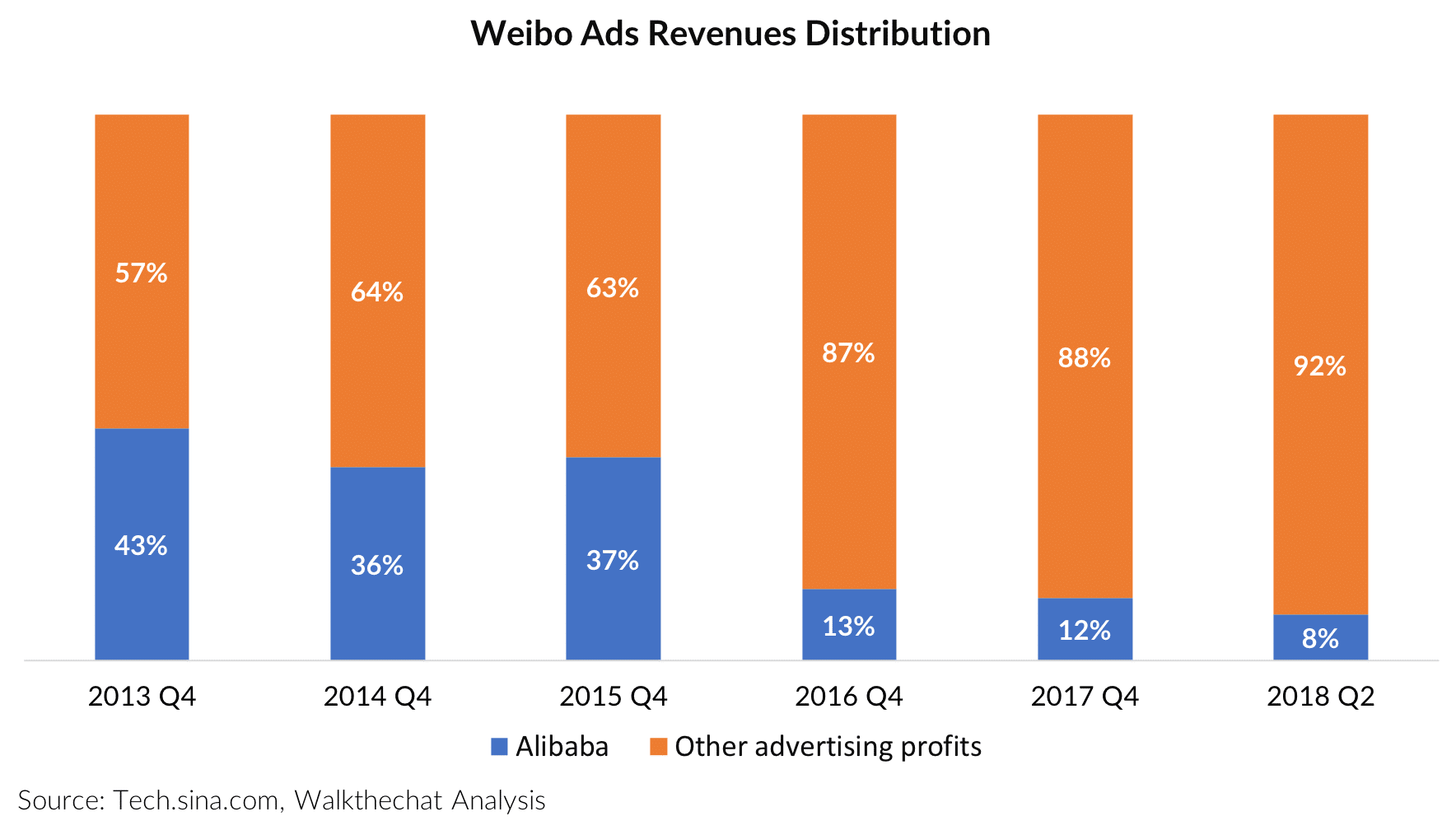
Are Weibo and Twitter fates intertwined?
Weibo was largely inspired by Twitter in its early days. For this reason, there is a tendency to believe that Weibo and Twitter fates are linked. Data seems to point in the other direction.
First of all, Weibo has seen a much steadier growth of its Monthly Active Users, and surpassed Twitter in 2017. Although growth for Weibo is slowing down, it remains much stronger than its Western competitor.

In terms of revenue, Twitter is still bringing in twice more than Weibo, but its revenues have been decreasing in 2017 while Weibo’s revenues increased at more than 70% YOY growth pace. It is likely that Weibo’s revenues will soon catch up with Twitter.
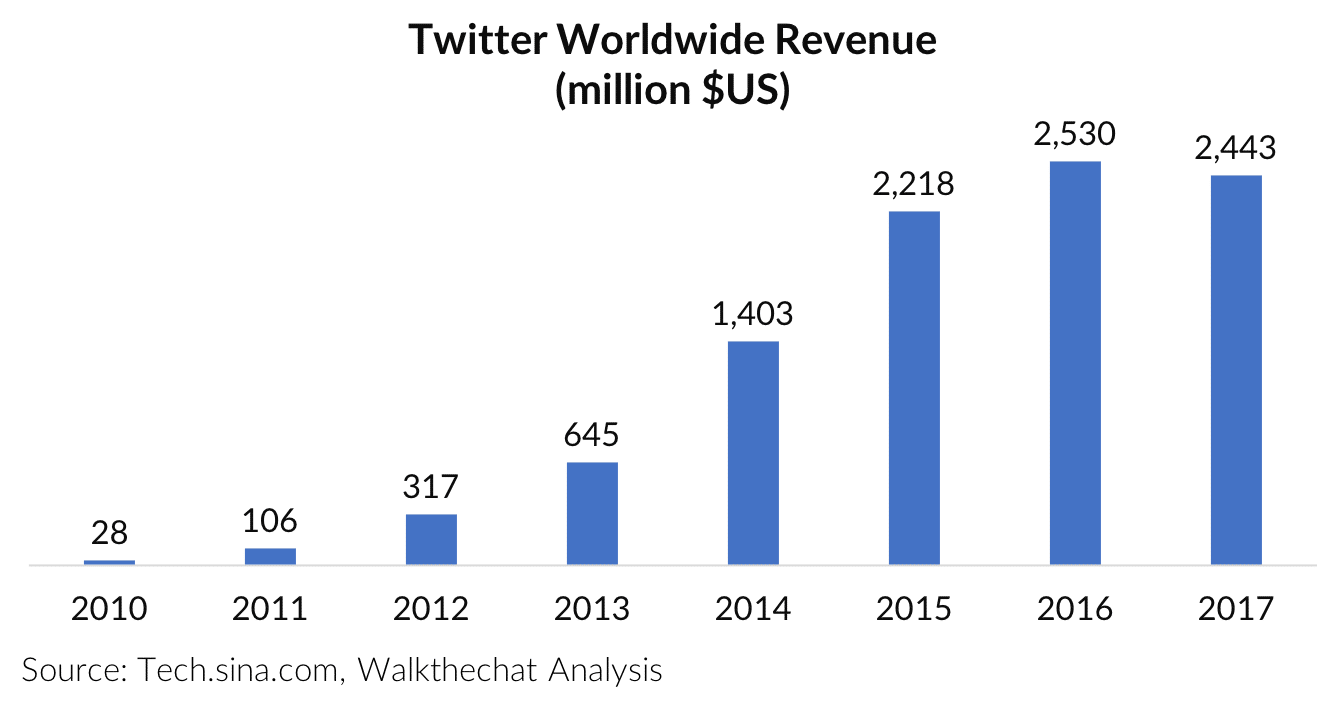
The reason for this discrepancy between Weibo and Twitter can be explained by the faster pace of innovation from Weibo.
For instance, Weibo opened up the 140 words limit, introduced the possibility of posting 9 photos and brought in videos and live videos on the platform; whereas Twitter failed to seize these opportunities which gave room for Instagram to take market share in photos sharing, while Youtube became its own video-centered social network.
CONCLUSION
Although Weibo is no longer in the limelight, it remains a powerful tool for users and advertisers alike.
Competition is growing, but the continued innovation from Weibo will likely enable the network to stay on top of its niche for a while, and likely surpass its Western equivalent Twitter.

